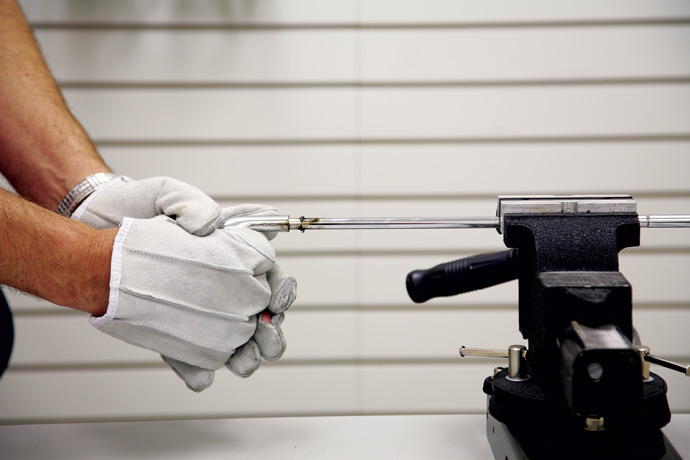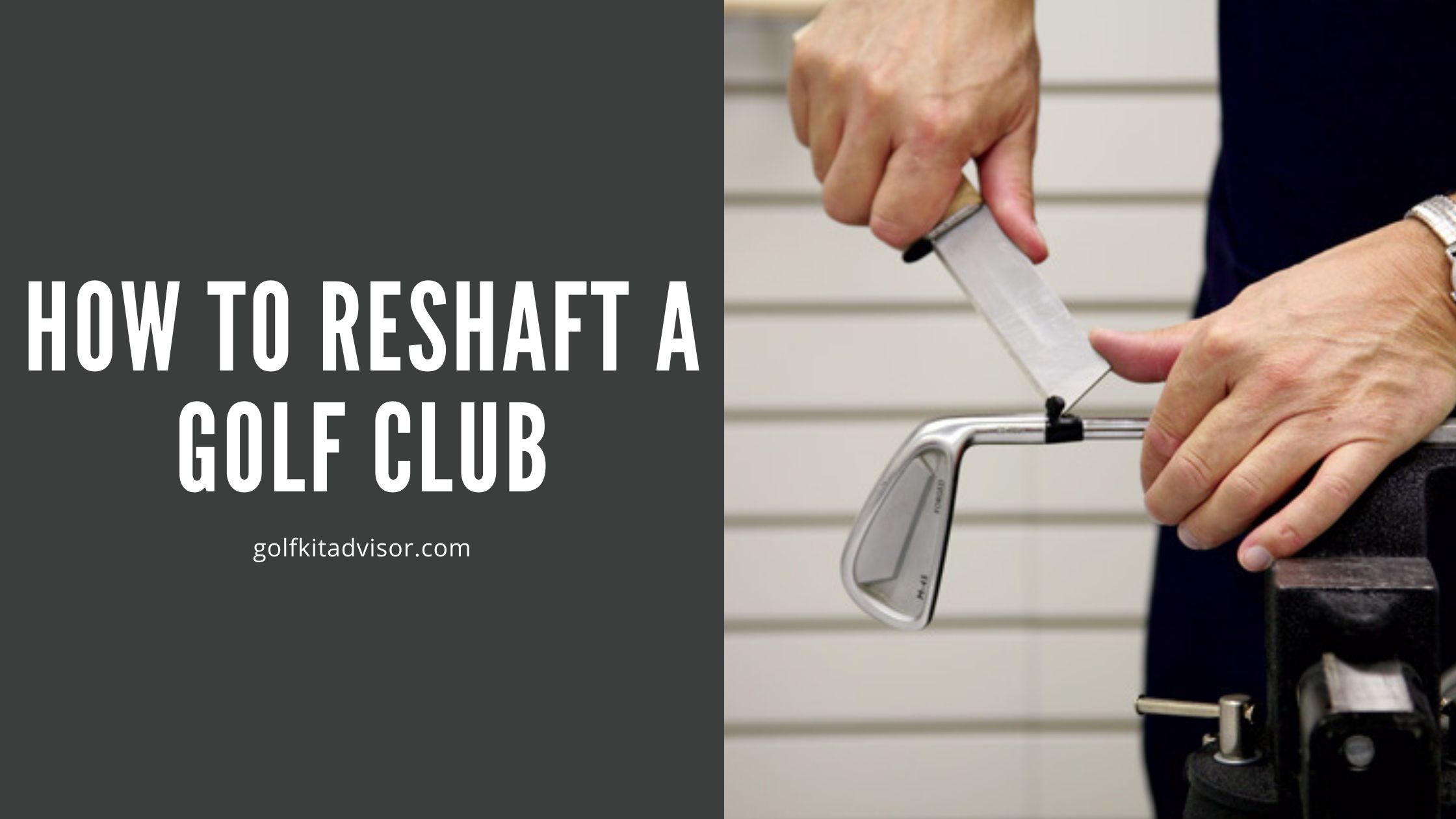Ever comes to your mind about how to reshaft a golf club yourself? When having your clubs reshafted, you’ll need to decide what type of shaft you want. There are three main golf club shafts: steel, graphite, and composite.
Steel is the most common and least expensive type of shaft. It offers good durability and performance but is heavier than the other two options. Graphite shafts are made from carbon fiber and are lighter than steel, making them a good choice for players who want to increase their swing speed.
Composite shafts are a mix of materials like graphite and Kevlar or fiberglass, which makes them lightweight yet strong. These are the most expensive type of shaft but offer the best performance. Once you’ve decided on the type of shaft, you need to choose a flex.
The flex is how much the shaft bends when you swing. There are five main types of flex: extra stiff, stiff, regular, senior, and ladies. Extra-stiff and stiff shafts are designed for players with a high swing speed who hit the ball long distances.
Regular and senior shafts are for players with an average swing speed who hit the ball medium distances. Ladies’ shafts have a lower flex rating and are designed for players with a slower swing speed. The last thing to consider is the length of the shaft.
The standard length for men’s clubs is 43 inches, but you can get them in lengths ranging from 41 to 46 inches. For women’s clubs, the standard length is 42 inches, but they can also be found in lengths from 40 to 44 inches.
If your clubs are reshafted, you can usually choose any combination of shaft type, flex, and length. Remember that changing any of these factors will affect how the club performs.

Table of Contents
Can You Re-Shaft A Golf Club Yourself?
The shaft of a golf club is the most important component in determining how well it performs. The shaft flexes and bends as you swing, affecting your ball’s trajectory and distance. A poorly designed or damaged shaft can result in an inconsistent shot that flies off to one side or another, leading to frustration on the course.
If you’re having difficulty with your clubs, it may be time to get them reshafted. Reshafting is the process of replacing the shafts on your golf clubs. This can be done for several reasons, including damage, wear and tear, or upgrading to a better-quality shaft.
The cost of re-shafting will vary depending on your type of shaft and where you have the work done. Depending on these factors, expect to pay anywhere from $40 to $200 per club.
How Much Does It Cost To Get Golf Clubs Reshafted?
Reshafting a golf club, is removing the old shaft from your golf club and replacing it with a new one. The cost to reshaft a golf club will depend on what type of clubs you have and how many clubs need to be reshafted.
Generally, the cost to reshaft a golf club will range from $30 to $100 per club.
Steps to Reshaft a Golf Driver
- Remove the old shaft from the clubhead.
- Cut the new shaft to length, leaving enough room for ferrules and grip tape.
- Install ferrule(s) onto the new shaft (and the old shaft if reusing).
- Slide the new shaft into the club head until it is flush with the hosel opening.
- Securely fasten the new golf club shaft using epoxy or another bonding agent per the manufacturer’s instructions – be sure to follow all safety precautions when working with chemicals! Allow ample time for the adhesive to cure before proceeding to the next step. 5. Install grip tape and grips onto the new shaft.
- Trim excess grip tape/grips, then replace the clubhead cover (if applicable).
Your golf club is now ready for use with its brand-new shaft!
When to Reshaft Your Golf Clubs
The shaft of your golf club is the most important part, and it’s not just for show. The shaft transfers energy from your swing to the ball, so if you’re having trouble with distance or accuracy, a new shaft could be what you need. But when should you replace it?
There are a few signs that it might be time for new shafts. It could be due to worn-out shafts if you’ve noticed a decreased distance or your shots are veering off to the side. Also, if you’ve changed your swing and aren’t getting the desired results, new shafts may help you adjust.
If you’re unsure whether new shafts will help your game, talk to a professional at your local golf shop. They can look at your clubs and give you their opinion on whether they need to be replaced.
Frequently Asked Questions
Can I Reshaft My Irons Myself?
Reshafting your irons is a job that is best left to professionals, especially if you do not have the right tools. Working with heated steel is dangerous for many reasons, but most of all because you can hurt yourself if you do not know what you are doing.
If you are set on reshaping your irons by yourself, here are a few tips:
- Always wear protective gear, including goggles, gloves, and ear plugs for your ears.
- Work in a well-ventilated section of the shop.
- Never let anyone touch the steel while it is heated.
- If the shaft has a threaded insert, have the right tap to remove it. If the insert requires a special tap, be sure to have professional use of the tap. This is an incredibly easy job to mess up, so unless you know what you’re doing, leave it to the professionals.
Are Graphite Shafts on Irons Good?
Yes, Graphite shafts can easily be found on nearly all graphite irons available today, ranging from the most expensive to entry-level irons. The main purpose of graphite is to use it as a lightweight replacement for steel shafts.
They are also used to create a lower center of gravity for better balance and accuracy. However, it is important to note that graphite shafts don’t necessarily work better than steel shafts, as each material has its benefits and disadvantages.
While graphite offers better distance and greater stability, it is also more susceptible to damage and has a shorter lifespan. As a result, experts recommend that beginners should not use graphite shafts.
How Do You Reshaft Irons With Graphite Shafts?
Reshafting irons with graphite shafts require special equipment and a good skill level. You cannot do it at home, but the professionals at your local club pro shop can handle it easily. The first step is to remove the existing steel shaft.
The easiest way is to get the right fitters and gradually use more pressure each time to wedge the shaft out of the hosel. You can also try grinding down the hosel and the shaft walls a little at a time if you want to risk damaging your shafts. Also, be careful not to force the shaft out too quickly and risk ruining the club head.
Can I Change My Steel Shafts to Graphite?
Yes, you can change the steel shafts to graphite or wood. However, according to USGA rules, a steel-shafted golf club consists of only a steel shaft and steelhead. Changing these two parts are not allowed.
Changing only the steel shaft for graphite will make it a non-conforming club, and you will be disqualified. Graphite shafted golf clubs are allowed to be used in competitions, and you can purchase a set of them.
Can You Reuse Golf Shafts?
You can reuse golf shafts, but you cannot reuse the grip. A golf shaft is made up of durable material called graphite. A golf shaft is much lighter than traditional wooden golf clubs, which makes it possible for golfers to have more power. The golf shaft’s durability makes it possible to be resold and reused.
There is, however, a catch; the shaft’s weight is set to a certain standard. A shaft lighter than that standard means it cannot be used on the golf course. It must, however, be sold as a replacement shaft. Aside from that, the shaft must be of the same length. The shafts can be bought in golf stores or on the internet.


